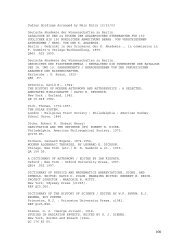K-6 Activities - Dudley Observatory
K-6 Activities - Dudley Observatory
K-6 Activities - Dudley Observatory
Create successful ePaper yourself
Turn your PDF publications into a flip-book with our unique Google optimized e-Paper software.
Materials<br />
• STARLAB Portable Planetarium<br />
• arrow pointers<br />
• Starfield Cylinder<br />
• red flashlights (for reading)<br />
Objectives<br />
K–6 <strong>Activities</strong> • B–32 •<br />
The Motion of Stars<br />
and Constellations<br />
Students will be able to:<br />
1. Observe that during rotation, Polaris stands still.<br />
2. Explain why seasonal stars rise and set and circumpolar stars do not.<br />
3. Tell which direction circumpolar stars appear to move around Polaris.<br />
Process Skills<br />
Describing • observing • interpreting • communicating • inferring • working cooperatively<br />
Background Information<br />
Share the following information with students.<br />
1. Northern circumpolar stars are located in the northern sky.<br />
a. The North Star is always above the North Pole.<br />
• The North Star does not appear to move in the sky.<br />
• It can be found by using the guardian stars of the Big Dipper.<br />
b. The circumpolar stars do not rise and set, but are always visible and revolve<br />
around the North Star.<br />
2. Stars appear to move rapidly in the night sky due to the rotation of the earth.<br />
a. Circumpolar stars revolve counterclockwise around Polaris.<br />
• The position of the stars changes about 15º each hour.<br />
• They make a complete revolution in a little less than 24 hours.<br />
b. In the southern sky, the stars move from east to west.<br />
• The stars that rise in the eastern part of the sky, set in the western part of<br />
the sky.<br />
• This movement in the sky is similar to that of the sun.<br />
3. The reason the stars do not come back to exactly the same place each night is<br />
due to the earth’s orbit of the sun.<br />
a. This motion is very slow.<br />
• The earth revolves around the sun in 365 and 1/4 days.<br />
• The star’s apparent motion to the west is about 1 degree each day.<br />
b. Constellations move to the west when observed at the same time each night.<br />
• Orion is seen in the southeast sky at 8 p.m. on January 1.<br />
• Orion is in the southern sky at 8 p.m. in the middle of February.<br />
• Late in March, Orion is in the western part of the sky at 8 p.m.<br />
Procedure<br />
Turn on diurnal motion to see how the stars appear to rise and set. Use the information<br />
above to provide astronomy concepts to students. Watch the circumpolar stars to<br />
see how they revolve around the North Star. Use the two “guardian stars” of the Big<br />
Dipper to go to the North Star, Polaris. Watch the stars in the southern sky move from<br />
east to west. Demonstrate night sky with daily motion.





